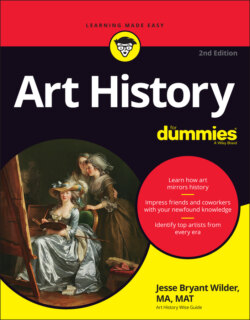Читать книгу Art History For Dummies - Jesse Bryant Wilder - Страница 105
The Egyptian Style: Proportion and Orientation
ОглавлениеThough it’s a very early work, the Palette of Narmer (see the preceding section) set the standard for all later Egyptian art. Once established, the Egyptian style hardly ever changed. Notice that part of the pharaoh is shown in profile, while the rest of him is represented in frontal view. In 3,000 years of Egyptian art, the pharaoh never changes his pose (in side-view reliefs and paintings). The pharaoh’s legs are always shown in profile, with the flat left foot planted in front of the right. The chest and shoulders are in frontal view, while the face is in profile (except for the right eye, which you see head-on, so to speak).
Consider these consistent aspects of Egyptian style:
Relative size does matter: Egyptian artists were ultra-conservative, probably because the main purpose of art was religious, and the Egyptian religion didn’t change much — not until the reign of Akhenaten in the New Kingdom (see “New Kingdom Art,” later in this chapter). All artists followed a canon of proportions when representing the human figure, sizing a man with an 18-unit grid. The unit could be based on a man’s shoe size or his fist. The knees, belly button, elbows, and shoulders had to be a specified number of units from the feet. This is why Egyptian royals look so much alike. The pharaoh was considered perfect and unchanging, like a god; therefore, his proportions had to be unchanging in art, regardless of the king’s actual dimensions. Only the lower ranks could be shown in more realistic poses, like the men harnessing the lionesses in the Palette of Narmer, whom you see from strict profile (except for their eyes) in more naturalistic positions.
Facing front, or not: Artists used the same canon of proportions to sculpt statues, but the figure was depicted frontally rather than in partial profile. Also, the left leg of the statue steps forward, more so in men than women (the more testosterone, the bigger the step), as in the statues of King Menkaura (sometimes spelled Menkaure) and his queen from the fourth dynasty. (You can see the statues online at the Museum of Fine Arts, Boston,
mfa.org). Despite their stoic faces, the statues reflect the intimacy and sculptural harmony of the pair. They look like they were made for each other. King Menkaura and his queen, who seem as durable as the pyramids, represent the stability of the Old Kingdom.
